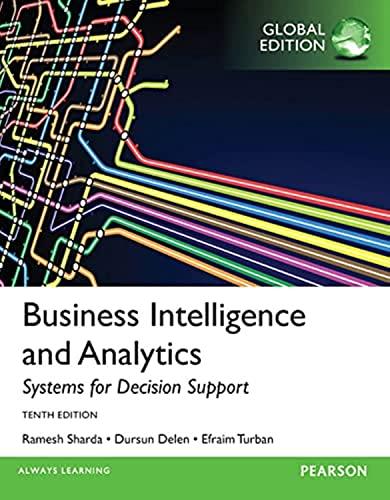Any athletic activity is prone to injuries. If the injuries are not handled properly, then the team
Question:
Any athletic activity is prone to injuries. If the injuries are not handled properly, then the team suffers. Using analytics to understand injuries can help in deriving valuable insights that would enable the coaches and team doctors to manage the team composition, understand player profiles, and ultimately aid in better decision making concerning which players might be available to play at any given time. In an exploratory study, Oklahoma State University analyzed American football-related sport injuries by using reporting and predictive analytics. The project followed the CRISP-DM methodology to understand the problem of making recommendations on managing injuries, understanding the various data elements collected about injuries, cleaning the data, developing visualizations to draw various inferences, building predictive models to analyze the injury healing time period, and drawing sequence rules to predict the relationship among the injuries and the various body part parts afflicted with injuries. The injury data set consisted of more than 560 football injury records, which were categorized into injury-specific variables—body part/site/laterality, action taken, severity, injury type, injury start and healing dates—and player/sport-specific variables— player ID, position played, activity, onset, and game location. Healing time was calculated for each record, which was classified into different sets of time periods: 0–1 month, 1–2 months, 2–4 months, 4–6 months, and 6–24 months. Various visualizations were built to draw inferences from injury data set information depicting the healing time period associated with players’ positions, severity of injuries and the healing time period, treatment offered and the associated healing time period, major injuries afflicting body parts, and so forth. Neural network models were built to predict each of the healing categories using IBM SPSS Modeler. Some of the predictor variables were current status of injury, severity, body part, body site, type of injury, activity, event location, action taken, and position played. The success of classifying the healing category was quite good: Accuracy was 79.6 percent. Based on the analysis, many business recommendations were suggested, including employing more specialists’ input from injury onset instead of letting the training room staff screen the injured players; training players at defensive positions to avoid being injured; and holding practice to thoroughly safety-check mechanisms.
Questions for Discussion
1. What types of analytics are applied in the injury analysis?
2. How do visualizations aid in understanding the data and delivering insights into the data?
3. What is a classification problem?
4. What can be derived by performing sequence analysis?
Step by Step Answer:

Business Intelligence And Analytics Systems For Decision Support
ISBN: 9781292009209
10th Global Edition
Authors: Efraim Turban, Ramesh Sharda, Dursun Delen, Pearson Education Limited, Dennis G. Zill





